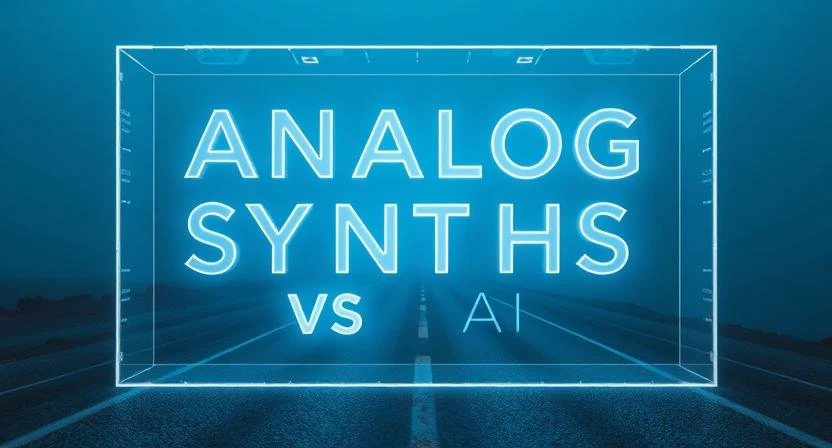Analog Synths vs. AI: A Sound Designer’s Love-Hate Rant

Let’s get one thing straight: I don’t own a warehouse full of vintage synths that smell like mothballs and existential dread. My “analog” setup lives inside my laptop, courtesy of plugins like Sylenth1, Serum, and Vital. You know, the perfect triad for people who want to sound like they’ve sold a kidney for gear, but actually just sold a kidney for coffee. (Priorities.)
That said, I’ve spent enough late nights arguing with wavetables and LFOs to have opinions about how virtual synths stack up against those trendy “type a word, get a sound” AI tools. Let’s unpack this mess.
Infinite Possibilities? More Infinite Headaches
Virtual analog synths like Serum and Vital are the digital LEGO sets for sound nerds. You can build anything — a bass that rattles teeth, a pad that sounds like a choir of ghosts, or a lead that’s basically just a dubstep goose honking Morse code. But here’s the catch: you have to actually know what you’re doing.
I once spent six hours designing a “thicc” bass in Serum, only to realize I’d accidentally left a frequency shifter on that made it sound like a kazoo trapped in a washing machine. My roommate walked in, paused, and said, “Is this what you went to college for?” (Yes. Yes, it was.)
But AI sound generators are the microwave dinners of creativity. Type “spooky forest ambiance,” and you’ll get 20 variations of wind chimes and owl hoots. But good luck asking it for “spooky forest ambiance, but make it sound like the trees are judging you.” The AI will blink at you like a confused golden retriever.
Customization: Building a Spaceship vs. Ordering Takeout
If you’ve ever tried to explain virtual analog synthesis to your grandma, you know the struggle. It’s like describing how to build a spaceship from a lawnmower engine. Every synth is a playground. Want a kick drum that shakes walls and includes a hidden Morse code message? Grab some LFOs, detune some oscillators, and hope you don’t break your CPU. I once layered so many unison voices in Serum that my laptop made a noise I can only describe as “mechanical regret.” Art.
Algorithm tools, though? That’s the Uber Eats of sound design: “angry robot squirrel”, generate, and, suddenly, almost but not exactly what you needed is staring at you. On the negative side, you cannot have a battle with an algorithm. “No, I don’t want ‘lo-fi glitch texture #47’, I want to hear the sound of a potato crying!” And the app sits there and just silently adds “potato crying” to your search history.
The Human Touch: Glitches, Gremlins, and Happy Accidents
Here’s the thing nobody admits: perfection is boring. Virtual analog gear is gloriously flawed. My Sylenth1 filter settings drift if I even think about automation. Last week, I stacked so many Vital wavetables that it started making a sound before I hit play. I didn’t question it — I sampled it. That’s the beauty. Synths don’t care about your plans. They’re chaotic roommates who occasionally leave pizza in the fridge but also write symphonies at 3 AM.
Virtual synths have this beautiful quirk: they’re only as good as your ability to out-stubborn them. For example, Sylenth1’s interface looks like it was designed in 2008 (because it was), but its simplicity is a superpower. No distractions — just knobs, a grid, and your poor life choices.
I’ll never forget the time I accidentally mapped Serum’s LFO to the panning instead of the filter cutoff. The result? A lead that danced left and right like it was dodging bullets in The Matrix. I kept it.
And, AI tools are the overachieving intern who follows the manual to the letter but panics if you ask them to “surprise you.” Sure, they’re getting scarily good at mimicking “vintage warmth” (looking at you, “tape saturation” plugins), but there’s still an uncanny valley of sound. Like when you realize that “organic percussion loop #12” is just a guy named Steve banging spoons in a basement, but smoother.
Why Pick a Side? (Spoiler: I Didn’t)
I’m not above using AI tools when I’m on deadline and my creativity’s running on fumes. Need 30 seconds of “cyberpunk traffic noises” by tomorrow? Fine, algorithm, do your thing. But for the sounds that matter — the ones that give a track personality — I’m diving into Serum or Vital every time.
Pro tip: Run your virtual analog monstrosities through those shiny algorithm tools. That Sylenth1 drone that sounds like a dying refrigerator? Slap it into a “cyberpunk ambiance generator,” and suddenly it’s the soundtrack to a rain-soaked neon dystopia. Sold a track like that last month. Thanks, Steve’s spoons!
Your Turn: Accept the Chaos
Virtual analog synths are for chefs who want to cook a 5-star meal. AI tools are for slapping peanut butter on toast and calling it “artisanal.” Both have their place, but only one lets you tell the difference between a phaser and a flanger without Googling.
From knob-twisting wizard to button-mashing pragmatist, the goal is the same: make noises that feel alive. If you’re curious, I’ve dumped some of my weirdest creations over on my Pond5 page—everything from “subway grate harmonics” to “what happens when you feed a synth too much coffee.”